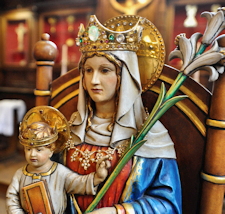Ordinary Time: September 24th
Thursday of the Twenty-Fifth Week in Ordinary Time
Other Commemorations: Our Lady of Walsingham (Memorial, England); Our Lady of Ransom (Hist) ; Other Titles: Our Lady of Mercy
» Enjoy our Liturgical Seasons series of e-books!
This is my prayer to you, my prayer for your favor. In your great love, answer me, O God, with your help that never fails: rescue me from sinking in the mud; save me from my foes.
The Blessed Virgin appeared in 1218 in separate visions to St. Peter Nolasco, St. Raymond of Penafort and James, king of Aragon, asking them to found a religious order dedicated to freeing Christian captives from the barbarous Saracens or Moors, who at the time held a great part of Spain. On August 10, 1218, King James established the royal, military and religious Order of our Lady of Ransom (first known as the Order of St. Eulalia, now known as the Mercedarian Order), with the members granted the privilege of wearing his own arms on their breast. Most of the members were knights, and while the clerics recited the divine office in the commanderies, they guarded the coasts and delivered prisoners. This pious work spread everywhere and produced heroes of charity who collected alms for the ransom of Christians, and often gave themselves up in exchange for Christian prisoners. This feast, kept only by the Order, was extended to the whole Church by Innocent XII in the 17th century.
Our Lady of Walsingham
In the year 1061 during the reign of Edward the Confessor, Our Lady appeared three times in a vision to a devout young widow, Richeldis de Faverches, Lady of the Manor of Walsingham in North Norfolk, England. Each time Our Lady showed the house in Nazareth where the Holy Family had lived, and requested that Richeldis build a replica to become a place of pilgrimage. Our Lady said: "Do all this unto my special praise and honor. And all who are in any way distressed or in need, let them seek me here in that little house you have made at Walsingham. To all that seek me, there shall be given succor. And there at Walsingham in this little house shall be held in remembrance the great joy of my salutation when Saint Gabriel told me I should through humility become the Mother of God's Son." Richeldis immediately did, constructing a house 23’6″ by 12’10” according to the plan given her. Its fame slowly spread, and in 1150 a group of Augustinian Canons built a priory beside it.
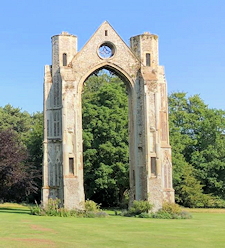 In the Middle Ages, Walsingham became one of the greatest pilgrimage sites in all of Europe. People from all walks of life: peasant, king, rich and poor, from Britain, Ireland and Europe. Even in the early 1500s, Henry VIII visited the Holy House of Walsingham more than once as a pilgrim. But Henry broke away from the Holy See and in 1538, confiscated and burned the Holy House of Our Lady of Walsingham. The magnificent priory church adjacent to it fell into ruin so that only a portion of the massive east wall is visible today. Of the Holy House itself, archeologists have found remnants of its foundation beneath a thin layer of ash on a rectangular knoll near the ruins of the priory church.
In the Middle Ages, Walsingham became one of the greatest pilgrimage sites in all of Europe. People from all walks of life: peasant, king, rich and poor, from Britain, Ireland and Europe. Even in the early 1500s, Henry VIII visited the Holy House of Walsingham more than once as a pilgrim. But Henry broke away from the Holy See and in 1538, confiscated and burned the Holy House of Our Lady of Walsingham. The magnificent priory church adjacent to it fell into ruin so that only a portion of the massive east wall is visible today. Of the Holy House itself, archeologists have found remnants of its foundation beneath a thin layer of ash on a rectangular knoll near the ruins of the priory church.
In 1896 a wealthy Anglican woman, Charlotte Boyd, commenced the restoration of the shrine, just as another wealthy woman had initially endowed it in the eleventh century. For pilgrims traveling from London to Walsingham, the last stopping place had been a chapel about a mile away known as the "Slipper Chapel," because they left their shoes there before walking barefoot the last mile to the shrine. The small fourteenth-century building was used as a barn to house animals prior to Charlotte Boyd's desire to restore it. Before her plan materialized, she became a Catholic, and in the 1890s bought the chapel and donated it to Downside Abbey. The Guild of Our Lady of Ransom took care of the restorations, and carved the statue of a standing Virgin and Child was given the place of honor. That statue is now in King's Lynn.
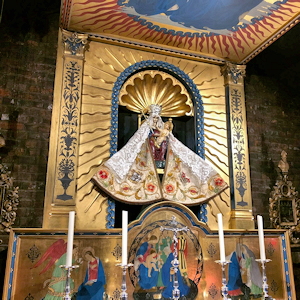 In 1897 Pope Leo XIII re-founded the ancient shrine of Our Lady of Walsingham, and pilgrimages are permitted to resume. On August 20, 1897, a procession of pilgrims from King's Lynn to the Slipper Chapel marked the renewal of public devotion to Our Lady of Walsingham. In 1922, the parish priest at the church of St. Mary the Virgin in Walsingham, Fr. Hope Patten, caused to have made a statue of Our Lady of Walsingham. He had discovered in the British Museum a medieval seal of the old monastery, and at its center was an image of our Lady -- presumably a representation of the image that had been destroyed at the Reformation. The statue of Our Lady was re-enshrined in 1922, beginning an era of cooperation at the shrine between Catholics and Anglicans.
In 1897 Pope Leo XIII re-founded the ancient shrine of Our Lady of Walsingham, and pilgrimages are permitted to resume. On August 20, 1897, a procession of pilgrims from King's Lynn to the Slipper Chapel marked the renewal of public devotion to Our Lady of Walsingham. In 1922, the parish priest at the church of St. Mary the Virgin in Walsingham, Fr. Hope Patten, caused to have made a statue of Our Lady of Walsingham. He had discovered in the British Museum a medieval seal of the old monastery, and at its center was an image of our Lady -- presumably a representation of the image that had been destroyed at the Reformation. The statue of Our Lady was re-enshrined in 1922, beginning an era of cooperation at the shrine between Catholics and Anglicans.
By 1931 the numbers had become too many for the parish church to cope with and a new shrine church was built, with the Holy House at its center and the image above its altar. So the Shrine of our Lady of Walsingham was reborn, and in our own time, it continues to draw thousands each year who, like the medieval predecessors come to discover the reality of “God with us,” and the effects of God’s loving and healing Grace and Love.
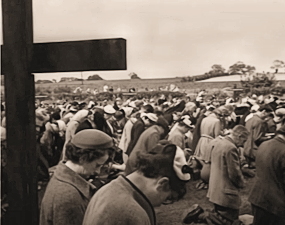 In August 1934 Cardinal Bourne led the Catholic bishops of England and Wales and ten thousand pilgrims to the Slipper Chapel, and from this date, it became the official Roman Catholic National Shrine. The four-hundredth anniversary of the shrine's destruction was commemorated in 1938 by a Pilgrimage of Catholic Youth, and in 1948 fourteen oak crosses were set up in the garden. There is a tradition for pilgrims to walk the last mile here barefoot. Many thousands of people have visited the Shrine—some come out of a spiritual need for the atmosphere of peace that seems to emanate from the Chapels, some for aesthetic reasons, whilst others merely stumble across us, nestled away in this secluded Norfolk Valley.
In August 1934 Cardinal Bourne led the Catholic bishops of England and Wales and ten thousand pilgrims to the Slipper Chapel, and from this date, it became the official Roman Catholic National Shrine. The four-hundredth anniversary of the shrine's destruction was commemorated in 1938 by a Pilgrimage of Catholic Youth, and in 1948 fourteen oak crosses were set up in the garden. There is a tradition for pilgrims to walk the last mile here barefoot. Many thousands of people have visited the Shrine—some come out of a spiritual need for the atmosphere of peace that seems to emanate from the Chapels, some for aesthetic reasons, whilst others merely stumble across us, nestled away in this secluded Norfolk Valley.
In 1981 construction began on the Chapel of Reconciliation, a cooperative effort between the two confessions, and located near the shrine. The feast of Our Lady of Walsingham was reinstated in 2000.
"When the Word was made Flesh, the universality of God came into the particularity of a little house in the village of Nazareth. The Incarnation means that God meets us not in an abstracted existence, but directly, within the particular places and circumstances of our lives. As Our Lady guided Richeldis to make a Nazareth in England, every chapel and shrine to Our Lady of Walsingham is a particular, local Nazareth, an encounter with the joy of the Incarnation in that special place." —Ordinariate of the Chair of Saint Peter.
—Excerpted from Mary-Pages and Catholic Saints Info
Patronage: East Anglia, England, diocese of England, Personal Ordinariate of the Chair of Saint Peter
Highlights and Things to Do:
- Visit the website of the Walsingham Catholic National Shrine and Basilica of Our Lady. There is also an Anglican Shrine and the Walsingham Abbey ruins.
- Read Mondays with Mary--Our Lady of Walsingham.
- Read more about the rededication of England as "Our Lady's Dowry."
- We can wonder, Was the original Walsingham statue really destroyed—or is it in the Victoria & Albert Museum?
- Read about the Pastoral Provision provided by Pope St. John Paul in 1980 (with more history from the Houston Cathedral.
- In 2012 the Personal Ordinariate of the Chair of Saint Peter for Anglicans joining the Church was given its patron as the Blessed Virgin Mary under the title Our Lady of Walsingham. See the website of the Cathedral of Our Lady of Walsingham in Houston, Texas. Today is a solemnity since it is their patronal feast.
Our Lady of Ransom
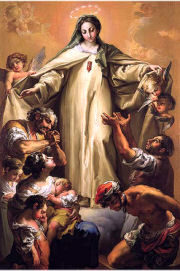 Would you risk your life to free someone from a concentration camp? Would you take the place of a prisoner? Would you sacrifice comforts and even necessities to save a slave? Would you pray and do penance for the freedom of Christian captives?
Would you risk your life to free someone from a concentration camp? Would you take the place of a prisoner? Would you sacrifice comforts and even necessities to save a slave? Would you pray and do penance for the freedom of Christian captives?
These things were done by the followers of Christ from the earliest days, but especially during the Middle ages. At that time the enemies of Christ's Church had conquered a great part of Christian territory and had carried off into slavery many thousands of Christians. Hit and miss, though heroic, efforts to free these unfortunates had been made here and there.
The Church decided to organize the work of ransoming slaves. In 1198 St. John of Matha and St. Felix of Valois founded the Trinitarians. From then until 1787 they redeemed 900,000 captives. The Order of Our Lady of Ransom, called the Mercedarians, and founded by St. Peter Nolasco, ransomed 490,736 slaves between the years 1218 and 1632. St. Vincent de Paul, a slave himself, led his priests to save 1200 Christian captives in the short period between 1642 and 1660 at the staggering cost of 1,200,000 pounds of silver. An even greater achievement was the conversion of thousands in captivity, and steeling them against the sufferings of a cruel martyrdom for the faith.
All this has been admitted by a modern, competent Protestant historian, Bonet-Maury. He records that no expedition sent into the Barbary States by the powers of Europe or America equalled "the moral effect produced by the ministry of consolation, peace and abnegation, going even to the sacrifice of liberty and life, which was exercised by the humble sons of St. John of Matha, St. Peter Nolasco, and St. Vincent de Paul."
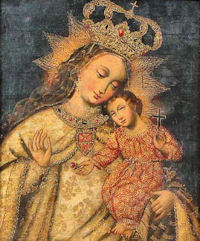 Our Blessed Mother herself appeared in a vision to St. Peter Nolasco, and requested him to found a religious order devoted to the rescue of captives. This was in 1218. Previous to that, since 1192, certain noblemen of Barcelona, Spain, had organized to care for the sick in hospitals and to rescue Christians from the Moors. St. Peter Nolasco, St. Raymond of Pennafort, and King James formed the new Order of Our Lady of Mercy. The group included religious priests who prayed and gathered the means, while the lay monks or knights went into the very camps of the Moors to buy back Christians, and, if necessary, take their very places. We have mentioned the magnitude of their success, a success that was won through the heavenly assistance of the Mother of Mercy, Our Lady of Ransom.
Our Blessed Mother herself appeared in a vision to St. Peter Nolasco, and requested him to found a religious order devoted to the rescue of captives. This was in 1218. Previous to that, since 1192, certain noblemen of Barcelona, Spain, had organized to care for the sick in hospitals and to rescue Christians from the Moors. St. Peter Nolasco, St. Raymond of Pennafort, and King James formed the new Order of Our Lady of Mercy. The group included religious priests who prayed and gathered the means, while the lay monks or knights went into the very camps of the Moors to buy back Christians, and, if necessary, take their very places. We have mentioned the magnitude of their success, a success that was won through the heavenly assistance of the Mother of Mercy, Our Lady of Ransom.
—Excerpted from the Feasts of Our Lady by Fr. Arthur Tonne
Patronage: Barcelona, Spain; people named Clemency, Mercedes, Mercedez, Merced or Mercy.
Highlights and Things to Do:
- Learn more about the spirituality, saints and history of the Order of Mercedarians who take a vow to risk their lives to save Christians who find themselves in extreme danger of losing their faith in the new types of captivity.
- Read more about the Mercedarians and Our Lady of Ransom.
- Wikipedia provides a good presentation of the variety of historical art portraying the Virgin of Mercy.
- We cannot take the places of those enslaved in their own land. We cannot buy freedom for those doing slave labor in the world. But we can and must beseech Our Lady of Ransom to show her powerful concern toward these suffering millions. We can beg her to help them find their way home. We can pray for her powerful intercession that slavery of all kinds may disappear from the earth. There is also a slavery of sin, from which she is eager to deliver us and our loved ones and all the world. Put yourself in the position of these displaced unfortunates. Imagine yourself exiled to a strange land, with strange customs, a strange language, and a merciless master. Picture yourself without a home, without friends, and often without your family. Above all let your heavenly representative and advocate, Our Lady of Ransom, know that you are interested, you are concerned, you are begging her help for these unfortunates. Best of all, attend Mass and receive Holy Communion and pray with the Church on this ever-timely feast.
Our Lady of Mercy
 Devotion to the Virgin of Mercy dates back to the time of the founding of Lima. It is known that the Mercederian friars, who came to Peru with the conquerors, had already built their primitive convent chapel around 1535. This chapel served as Lima's first parish until the construction of the Main Church in 1540. The Mercederians not only evangelized the region, but they also participated in the city's development, building beautiful churches that have been preserved as a valuable cultural and religious patrimony.
Devotion to the Virgin of Mercy dates back to the time of the founding of Lima. It is known that the Mercederian friars, who came to Peru with the conquerors, had already built their primitive convent chapel around 1535. This chapel served as Lima's first parish until the construction of the Main Church in 1540. The Mercederians not only evangelized the region, but they also participated in the city's development, building beautiful churches that have been preserved as a valuable cultural and religious patrimony.
With these friars came their celestial patroness, the Virgin of Mercy, a Marian title of the thirteenth century. Tradition has it that around 1218, St. Peter Nolasco and James I, King of Aragon and Catalonia, experienced separately a vision of the Most Holy Virgin who asked them to found a religious order dedicated to rescuing the many Christian captives held by the Moslems. This Order of Our Lady of Mercy, approved as a military order in 1235 by Pope Gregory IX, was able to liberate thousands of Christian prisoners, and later became dedicated to teaching and social work. The Mercederian friars' habit imitates the garments worn by the Virgin when she appeared to the founder of the order. [Our Lady of Our Lady of Mercy] The image of the Virgin of Mercy is dressed all in white: over her long tunic she wears a scapular with the shield of the order imprinted breast high. A cloak covers her shoulders and her long hair is veiled by a fine lace mantilla. Some images have her standing, with the child in her arms, and others with her arms extended showing a royal scepter in her right hand and in the left some open chains, a symbol of liberation. Such is the appearance of the beautiful image venerated in the Basilica of Mercy in the capital of Peru. It was enthroned at the beginning of the XVII century and has been considered the patroness of the capital. In 1730 she was proclaimed "Patroness of the Peruvian Lands" and in 1823 "Patroness of the Armies of the Republic." On the first centennial of the nation's independence, the image was solemnly crowned and received the title of "Grand Marshall of Peru," on September 24, 1921, Feast of Our Lady of Mercy, since then declared a national holiday, when every year the army renders homage to her high military rank.
The image carries numerous decorations granted by the Republic of Peru, its governors and national institutions. In 1970 the town council of Lima gave her the "Keys of the City," and in 1971 the president of the Republic conferred on her the Great Peruvian Cross of Naval Merit, gestures which evidence the affection and devotion of Peru to Our Lady of Mercy, that many consider their national patroness.
—Excerpted from All About Mary
Meditation: Ember Saturday, A day for expiation and thanksgiving!
This excerpt from Pius Parsch is based on the 1962 Missal. The current Missal does not include special propers and readings for Ember Days.
1. Holy Mass (Venite). Ember Saturday is the official thanksgiving day for all the blessings of the past quarter-year. Especially in autumn when we garner the fruits of nature should we be more conscious of God’s Providence both in the temporal and spiritual orders. In ancient times today’s Mass served as a thanksgiving sacrifice and as a renewals of the Christian covenant with God. The text presumes that the Ember days are the Christian counterpart to the Old Testament feasts of Atonement and Tabernacles, highlighting penance and and gratitude respectively.
The liturgical celebration, observed during the night between Saturday and Sunday and of obligation for all the faithful, was unusually festive. The faithful gathered at St. Peter’s for an entrance song the Invitatory (Psalm 94) was sung. The first four Lessons belonged specifically to the night-vigil and formed a greeting worthy of the enthroned King. The Readings tap the marrow of the Ember celebration, its connection with the Jewish feasts of the seventh month, Yom Kippur and the feast of Tabernacles. The autumn Ember days are days of penance for past failings and of gratitude for the harvest (and redemption); such too is the spiritual import of the Lessons. The first reviews the Mosaic legislation concerning the Day of Atonement, the second concerning the feast of Tabernacles, Israel’s great thanksgiving feast.
The two Graduals echo their respective Lessons; the first “Forgive” (Day of Atonement), the second, “How lovely are Thy tabernacles” (feast of Tabernacles). The third and fourth Lessons, from the prophets Micheas and Zacharias, are comforting messages in which God reaffirms His readiness to forgive the sins of His people and to grant them good things provided they remain faithful. God is also concerned over the manner in which we fast: “The fast of the fourth month, and the fast of the fifth, and the fast of the seventh, and the fast of the tenth shall be to the house of Judah joy and gladness and a great solemnity!” By which our Ember days, of course, are meant. The Orations offer God our festive fast and plead forgiveness. As on other Ember Saturdays, the fifth Lesson is already part of the morning service; the assembled faithful are praying Lauds; the three youths in the fiery furnace prefigure the resurrection of Christ and of Christians.
In the Epistle St. Paul shows how the ceremonies of the old covenant were types of the new; our day of atonement is Good Friday when Christ, the divine High Priest, entered the most holy sanctuary of heaven with His own Blood and wrought eternal redemption; every Mass is Good Friday repeated. In the Tract we chant the shortest Laud psalm as we express our gratefulness for God’s merciful work of redemption and HIs fidelity in fulfilling the prophecies.
Presently the High Priest Himself appears, first “teaching on the Sabbath” (in the Foremass), then offering Himself (in the Oblation). The unfruitful “fig tree in the orchard” and the “bowed-down woman” are the faithful. God is the landlord, Christ the pleading gardener; till now we have been unfruitful.
We also resemble the bowed-down woman; wholly taken up with earthy concerns, too often we are “unable to look upward”; but on this Christian Sabbath, Christ seeks “to free us from the bonds of Satan” and make us spiritually “erect.” Thus the Gospel insinuates the workings of grace in today’s holy Sacrifice.
At the sacrificial Banquet we once more recall the institution of the feast of Tabernacles as a remembrance of the deliverance from Egypt and the wanderings through the wilderness—for the Eucharist is the fulfillment of those two historical events by providing deliverance from sin and the true Manna from heaven. A classic, thought-packed Postcommunion: May the sacramental energy of the Eucharist realize its power in us, and may we one day enjoy face to face what now we see in a veiled manner. Three realities are noted: the first is the sign—this shows the sacrament. Underneath the sign is hidden the second reality, the sacrament’s efficacy—what the sacraments contain. And lastly, the rerun veritas, the future unveiling.
2. A “Spiritual Renewal” Day. For a “day of recollection” no better meditation points could be found than those in the Lessons of today’s Ember Mass. Of the two areas of thought proper to the formulary, viz., the Ember festivity is the Christian “Day of Atonement” and the Christian Feast of Tabernacles (or thanksgiving day at harvest time), let us pursue the former in some detail.
a) The Old Testament type. The Day of Atonement, Yom Kippur, was the great penitential observance of Mosaic Law, Israel’s “confession day.” With us “penance days” are not feast days, but among the Jews it was otherwise; Yom Kippur was a day of strict rest, absolutely no type of work was permitted and the spirit of the occasion was festive, celebrabitis. The day’s liturgy exemplified the nation’s effort to expiate sin; on this one day of the year, the high priest would enter the Holy of Holies with sacrificial blood and sprinkle the ark of the covenant in atonement for his own and his people’s sins. Meanwhile the people did penance through fasting, humbling themselves before Yahweh.
b) The New Testament fulfillment. Mosaic festivals were shadows which took on flesh and blood in the Church of Christ. Good Friday was the real, the unique day of atonement in the sight of God. How well St. Paul affirmed this truth in the Epistle of today’s Mass: “Christ appeared as the high priest of coming (Messianic) blessings. He entered the greater and more perfect tabernacle not made by human hands (i.e., heavenly in nature) not with the blood of goats and steers but with His own blood—once and for all He entered the (heavenly) Holy of Holies—after He had effected an eternal redemption (i.e., one with lasting effects in contrast to the annually repeated Jewish day of atonement).” For the sacrifice on the Cross constituted the perfect reconciliation of God with mankind; and every holy Mass, as it renders present that sacrifice on Golgotha, is Yom Kippur par excellence.
Every Sunday then would be the Christian atonement feast. But because we Christians are so irresponsive and dull to the inner nature of spiritual realities, holy Church introduced special expiation days during the course of the Church year. Among these are Ember days. Ember Saturdays, particularly September Ember Saturday, have preserved best this original spirit. Anyone who seeks to develop his spiritual life on a liturgical basis would have to use the Ember days during the four seasons as times of genuine spiritual renewal. The peculiar means of keeping these days is evident from the liturgy itself—acts of penance and fasting, confession of sin, humbling ourselves before God and neighbor, and nevertheless rejoicing, in the best sense of the word. Our conduct would exemplify the prophet’s statement (fourth Lesson), “The fast proper to the fourth, fifth, seventh and tenth months (i.e., the four Ember weeks) should mean joy and exultation to the house of Judah (viz,, Catholics) and high festival; you only need to love truth (obedience) and peace.”
c) Application. God appeals directly to my heart in the Gospel. The two parables, one in word and one in sign, should move me deeply. I am that barren fig tree. The infinitely just God is the landlord, our Savior the pleading caretaker. If God should summon me to His judgement seat today (the command to destroy the tree), would there be any “fruit”? To what extent would I resemble the barren fig tree? Why does it occupy ground? But Christ intercedes, says a kindly word in my behalf: “Perhaps there will be some return—next crop! If not, it can then be cut down.” The coming quarter-year mark must mark a change, genuine improvement.
The parable in sign is equally instructive. My soul is so badly bowed down to earth, it find “looking upwards” toward heavenly realities extremely painful. Christ must make me stand erect again. The coming season as no other is the season of hope, of preparation for the parousia, of longing for the heavenly Jerusalem, of expectation for the returning Lord. Jesus, have mercy. Free me from stooping down to the earthly, the sensual. Straighten me out for heaven. Now! Jesus, have mercy.
—Excerpted from Pius Parsch, Year of Grace, Volume 5.





